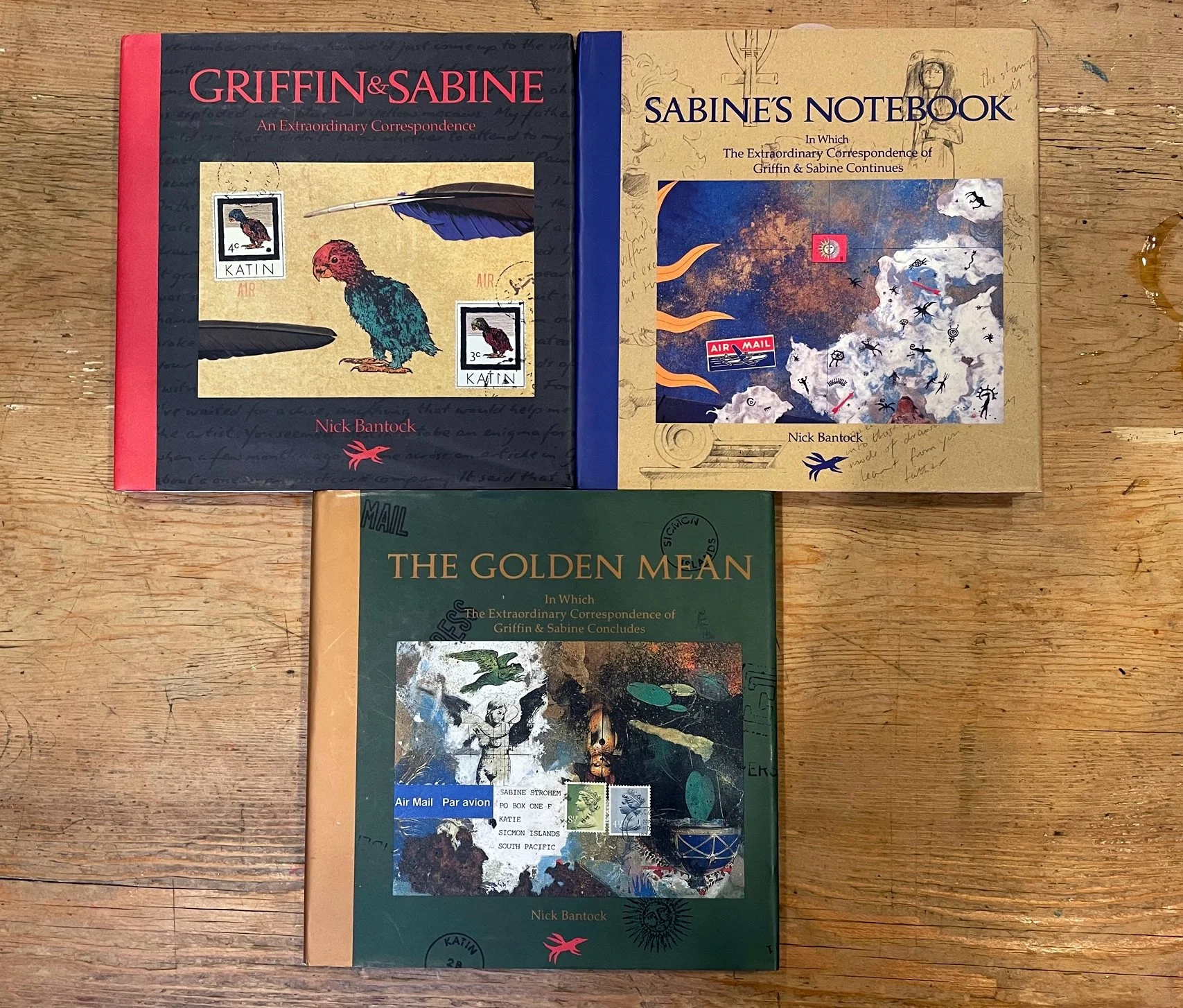I fell in love with Nick Bantock’s Griffin and Sabine: An Extraordinary Correspondence. When the book came out back in 1991, I remember seeing it at a local bookstore and picked it up as I wanted to go on a journey and experience something that I had never had before.
You see, Bantock’s book is unique in that it’s not only filled with amazing artwork, but he tells the story of how Griffin and Sabine correspond with each other through letters. Bantock designed the letters and you’re able to pull them out of an envelope and read the words as though you’re taking part in their correspondence yourself.
I had never owned a book like Griffin and Sabine before. I didn’t know what to expect or what I’d find, but one thing became clear: I fell in love with the romance of two people corresponding through letters and art.
In 1991, I was still in college as an English Literature and French major. I studied Keats, Shelley, and Whitman. I believed that writing could change the world. Back then, I thought that art was more important than anything because what we dream up, what we share, is a unique insight into our most intimate and pure self.
In the Griffin and Sabine books, I became sucked into the romance of two people who wrote to each other and used those words to forge a strong relationship between them.
In the before times (before mobile phones and the internet), I would write to my friends—long letters filled with my most secret thoughts. My worries, hopes, and dreams. I would send those letters out with love to Germany, France, and different parts of the United States to my various friends). And the letter would take sometimes a week to reach its destination.
I created my letters from the heart and I would craft them individually to each person. Since I had to wait for the letter to reach my friend, there might be weeks before I heard back from them. They would send me a letter back and those words meant more to me than money.
The joy of opening a letter and not knowing what the person would write (or draw for me) is lost in today’s instant gratification culture. Now I pull my phone out, text my children, and expect an answer in minutes.
The world has changed, and I understand an accept that, but there’s something about looking back and rediscovering the joy of corresponding with someone.
Reading the story of Griffin and Sabine, is a great way to feel nostalgic again, and to fall back in time to a different place and get lost in a mystery. Who is Sabine? Will Griffin ever meet her?
I don’t want to give any of the story away, but it’s worth picking up the books and going on the journey with them. My favorite book is the first one, but the second book (Sabine’s Notebook) is filled with such creative artwork that is worth the cost of the book. And the original series concludes with The Golden Mean.
Last year during quarantine from Coronavirus, I gave the books to my teenage son. He had started writing intricate letters to his friends (gluing dried flowers and really cool artwork) and I thought he would enjoy reading the series. He loved the books and a part of me smiled: When I read Bantock’s books back in 1991, I hoped that one day I would get married, find the love of my life, and have children. I hoped that one day I could share laughter, art, and get to sit back to learn from my kids. I am honored and humbled to have the privilege of becoming a father.
Although the world has morphed to facetimes, tweets, and texts, there is still a chance to explore the written word. The Griffin and Sabine books always bring a smile to my face as I look on them as works of art and the books remind me of my youth.
A time when I could craft a letter and put a piece of my soul into the words on the page. Like a magical jewel that glowed in the night, I could bring someone on a journey through my words. By using words and weaving a story, I could bring a friend into my confidence, share with them how I felt, and what I dreamed. I love doing that.
I think that’s why I started writing books: I can become anyone I can dream up. When I wrote my first Cinderella book (Lost), I chose to make it an epistolary novel because I wanted to capture a feeling and a mood. I wanted to get into the mind of a 19-year-old girl and to channel her fear, worry, and her hopeless love of falling in love. Cinderella falls hard in my book and it’s not always flattering on how needy she is. But that’s part of writing in a way that opens up the light to one’s most innermost desires—we’re human and we make mistakes.
I don’t know if Griffin and Sabine directly influenced parts of my Cinderella novel, but I did experiment with several unusual styles in the print version of the book. I won’t say why, but there are certain sentences in which the text on the page is upside-down. For the Kindle version, I couldn’t reproduce that same technique, so I wrote the sentences backward. It doesn’t quite have the same feel as seeing a sentence upside-down, but I had to work with what the technological limitations.
In Bantock’s books, he wrote the Griffin and Sabine books to include both tactile and visual art. In my book Lost, I do include one image and the upside-down text, so that’s my way of experimenting beyond the page.
Decades have passed since I first encountered Griffin and Sabine and their wondrous journey through letters, but if you’ve never heard of the books, you can experience them for the first time. I invite you to check the books out. In our fast-paced world, they’re well worth picking up!
Please note that there are affiliate hyperlinks used on this page and that I receive a small percentage of sales if you choose to purchase. I only recommend items that I have found helpful and useful, and am passing them on to you to help. Thank you!


